Cryotherapy, the therapeutic use of extreme cold to treat various physical conditions, has become an increasingly popular recovery method among professional athletes seeking faster muscle regeneration. The treatment typically involves exposing the body to subzero temperatures, often in a cryochamber or via localized cold therapies such as ice baths and cryo-compression. The rationale behind cryotherapy is that the rapid exposure to cold constricts blood vessels and decreases metabolic activity, which reduces inflammation and muscle tissue breakdown following intense physical exertion. Once the body is removed from the cold environment, blood vessels dilate, leading to a rush of oxygen-rich blood to the muscles. This vasodilation promotes faster healing by flushing out toxins and delivering nutrients critical to muscle repair. One of the primary benefits of cryotherapy in muscle regeneration is its ability to reduce delayed onset muscle soreness DOMS, common issue athletes face after strenuous workouts or competitions. DOMS can impair performance and training consistency, but cryotherapy has been shown to alleviate soreness and enable quicker return to peak physical activity.

By minimizing the severity and duration of inflammation, the therapy helps maintain training intensity and frequency, which is essential for elite athletes. Moreover, cryotherapy poole stimulates the release of endorphins and norepinephrine, which not only improve mood but also act as natural pain relievers, thereby reducing the need for pharmacological interventions. Another mechanism through which cryotherapy aids in muscle recovery is by enhancing the production of anti-inflammatory cytokines and suppressing pro-inflammatory markers in the body. This cellular-level modulation reduces systemic inflammation and accelerates the regeneration of muscle fibers damaged during exercise. The cold exposure also influences the activity of satellite cells, which are crucial for muscle repair. These cells are activated to proliferate and fuse with existing muscle fibers, facilitating tissue regeneration and increasing muscle strength over time. Additionally, some studies suggest that cryotherapy improves antioxidant capacity, which helps neutralize free radicals generated during intense physical exertion. This further protects muscle cells from oxidative stress and expedites healing.
Cryotherapy’s psychological benefits also play a vital role in athletic performance and recovery. The intense cold exposure triggers a fight-or-flight response, stimulating the central nervous system and increasing alertness. This neurological stimulation may enhance neuromuscular coordination and focus, which are vital during high-level athletic training and competition. Athletes often report feeling revitalized and mentally sharp after cryotherapy sessions, which contributes to improved performance consistency. Although the effectiveness of cryotherapy can vary depending on the method used, frequency, and the individual’s physiological response, its benefits in promoting faster muscle regeneration are widely recognized in the professional sports community. Teams across various disciplines including football, basketball, track and field, and mixed martial arts routinely incorporate cryotherapy into their recovery protocols. As research continues to explore the precise molecular and systemic effects of cold exposure, cryotherapy remains a cornerstone of modern athletic recovery strategies. By mitigating muscle damage, reducing inflammation, enhancing circulation, and promoting cellular repair, cryotherapy offers a multifaceted approach to muscle regeneration, ultimately enabling athletes to train harder, recover faster, and perform at their highest potential.








